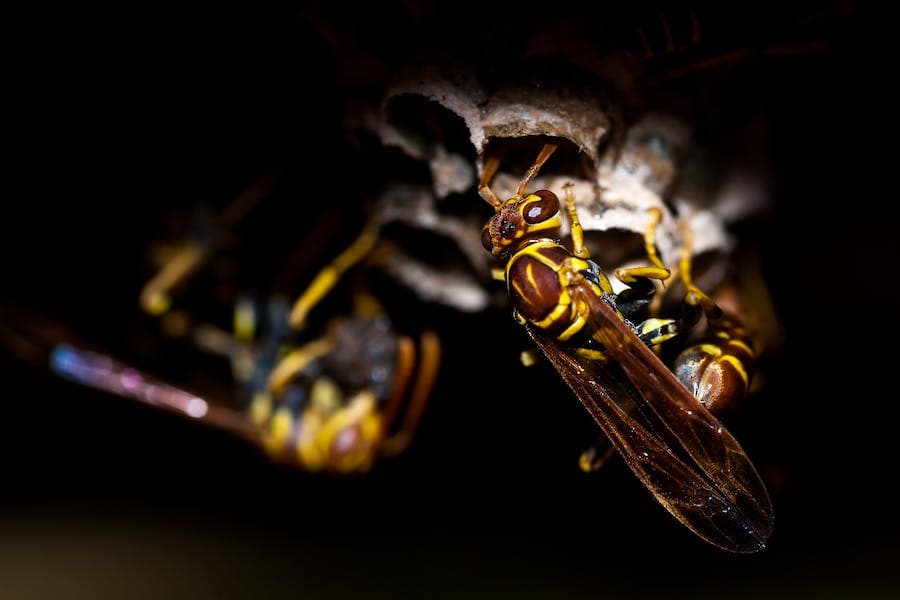With their distinctive appearance and often misunderstood reputation, wasps play vital roles in our ecosystems as predators and pollinators. Yet, one question that has remained largely unanswered is whether these insects sleep at night. While we may be more familiar with the sleeping habits of animals like mammals and birds, the insect slumber world is filled with intriguing mysteries. This article will delve into the enigmatic world of wasp behavior after dark, shedding light on whether these buzzing insects take a nightly rest and exploring the implications of their nocturnal activities. Understanding the sleeping habits of wasps satisfies our curiosity and holds potential implications for pest control and conservation efforts.
Do Wasps Sleep At Night?
Yes, wasps do sleep at night. Like many other insects, wasps have distinct periods of rest at night when they become less active. However, their sleep patterns can vary depending on species, environmental conditions, and their specific role within a colony. While not much is known about the details of their sleep behavior, it is clear that wasps, like most creatures, take some form of nightly respite from their daily activities.
The Life Of A Wasp
The life of a wasp is a fascinating journey characterized by distinct stages and unique behaviors. Here’s an overview of the life of a typical wasp:
Egg Stage: The life of a wasp begins as an egg laid by a mated female wasp. Depending on the species, these eggs are usually laid in sheltered locations, such as nests, crevices, or inside plant stems.
Larval Stage: After hatching from the egg, the wasp enters the larval stage. During this phase, the larva depends entirely on its adult counterparts or the queen wasp for food and care. The larva proliferates, molting several times as it develops.
Pupal Stage: Following the larval stage, the wasp enters the pupal stage. During this time, the wasp undergoes a remarkable transformation, like a caterpillar turning into a butterfly. The pupa is encased in a protective cocoon, and inside, the body undergoes significant changes as it prepares to emerge as an adult wasp.
Adult Stage: Once the metamorphosis is complete, the wasp emerges from its pupal stage as an adult. Adult wasps have distinct features depending on whether they are social or solitary. Social wasps, like yellowjackets and hornets, live in colonies with a structured hierarchy consisting of a queen, workers, and drones. Solitary wasps, on the other hand, live and hunt alone, without the elaborate social structure seen in their social counterparts.
Reproductive Role: The primary role of adult wasps is to reproduce. In social colonies, the queen is responsible for laying eggs, while the worker wasps gather food, care for the young, and defend the nest. Male wasps, known as drones, typically do not have a long lifespan and are primarily involved in mating.
Foraging And Nest Building: Both social and solitary wasps are known for their hunting and foraging skills. They feed on nectar, fruit, or other insects, which makes them important pollinators. Social wasps construct elaborate nests made of paper-like material, while solitary wasps create individual nests for their offspring, often as burrows or mud cells.
Lifecycle Variation: The lifespan and activities of a wasp can vary greatly depending on the species. Some wasps are annual, meaning they complete their entire life cycle within a single season, while others are perennial and may live for several years.
Scientific Research On Wasp Sleeping Habits
Scientific research on wasp sleeping habits is relatively limited compared to studies on more well-known insects or animals. However, some studies have provided insights into the sleeping patterns of wasps. Here’s an overview of some key research findings:
Nocturnal Rest:
One common observation across various wasp species is that they exhibit periods of nocturnal rest. During the night, wasps become less active, decreasing their metabolic rate. This behavior is similar to sleep in other animals, though it might not be as deep or prolonged.
Environmental Factors:
Research has shown that environmental factors, such as temperature and light, significantly regulate wasp sleep patterns. Wasps tend to rest more during cooler nighttime and in darkness, suggesting that external conditions influence them.
Social Behavior:
In social wasp species like yellowjackets and paper wasps, the behavior of the colony as a whole can affect individual wasps’ sleep patterns. Workers may collectively enter a state of rest within the nest, often at night, while some individuals remain active to guard the nest.
Individual Variability:
Not all wasps within a colony or species sleep simultaneously or for the same duration. There can be individual variability in sleep patterns, with some wasps being more active at night than others. This variability may be related to their specific roles within the colony.
Sleep And Reproduction:
Some research has suggested a link between sleep and reproduction in wasps. For example, queen wasps may reduce their activity and rest more during the early stages of colony founding or when preparing to hibernate for the winter.
Limited Studies:
It’s essential to note that the available scientific research on wasp sleep is relatively limited, and many aspects of their sleep behavior still need to be better understood. Compared to other insects like bees or ants, wasps have received less attention from researchers in this regard.
Future Research:
Given the ecological importance of wasps and their potential impact on pest control and pollination, there is a need for more comprehensive studies on their sleep habits. Future research could explore the neural mechanisms underlying wasp sleep, the effects of sleep deprivation, and how sleep patterns vary among different wasp species.
Potential Factors Influencing Wasp Sleep Patterns
Several factors can influence the sleep patterns of wasps, shedding light on their intriguing nocturnal behavior. These factors include environmental conditions, social dynamics within the colony, and individual roles within the wasp community. Understanding these influences is crucial for unraveling the mysteries of wasp sleep:
Wasps are highly responsive to environmental cues such as temperature and light. Cooler nighttime temperatures often induce a state of rest in wasps, while darkness tends to discourage activity. These external conditions can significantly shape their sleep patterns.
Social wasps, like yellowjackets, hornets, and paper wasps, live in colonies with complex hierarchies. The division of labor within the colony can affect when and how individual wasps rest. Workers may collectively enter periods of rest within the nest, while some individuals remain active to guard the nest or care for the brood.
Different wasps have specific roles and responsibilities within a colony. Queens, for instance, focus on reproduction, while worker wasps gather food and protect the nest. These distinct roles may lead to variations in sleep patterns among individuals, with some being more active during the night to fulfill their duties.
The developmental stage of the wasp colony can also influence sleep patterns. For example, during the early stages of colony founding or when preparing to hibernate for the winter, wasps may exhibit altered sleep behaviors in response to the changing needs of the colony.
Like many organisms, wasps have internal biological clocks or circadian rhythms that regulate their daily activities, including sleep. Genetic factors can influence these rhythms and respond to environmental cues, helping wasps align their sleep patterns with the natural day-night cycle.
The availability of food sources, such as nectar or prey, can impact wasp foraging and, consequently, their activity patterns. Wasps are more likely to be active when there is an abundance of resources to collect. The risk of predation, both from natural predators and from humans, can influence when wasps choose to rest. Reduced activity during nighttime may be a strategy to avoid potential threats.
Conclusion
whether wasps sleep at night unveils a captivating aspect of these enigmatic insects’ lives. While scientific research on their sleep habits remains relatively limited, it is evident that wasps exhibit periods of nocturnal rest influenced by various factors. Environmental conditions, social dynamics within the colony, individual roles, and circadian rhythms all shape their sleep patterns. Understanding these influences is not only a matter of curiosity but also holds implications for pest control, pollination, and conservation efforts. Further research into the intricacies of wasp sleep behavior is essential to unravel the mysteries of their nocturnal activities and to appreciate their role in maintaining the balance of ecosystems.








